20-03-2013
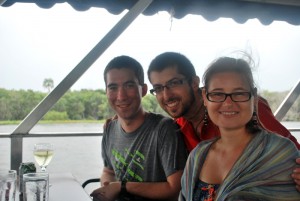 I’ve been
dreaming
for a long time to meet a hippo up close and personal. Marlowe always jokes that I would jump in the water at first sight and try to hug a 7,000-pound animal. When I heard hippos lived close to Victoria Falls, I naturally wanted to start arranging for sights to see and do as soon as possible after arriving at the Falls (in spite of an enormous tiredness that fell over me after
our long journey from Maputo
).
I’ve been
dreaming
for a long time to meet a hippo up close and personal. Marlowe always jokes that I would jump in the water at first sight and try to hug a 7,000-pound animal. When I heard hippos lived close to Victoria Falls, I naturally wanted to start arranging for sights to see and do as soon as possible after arriving at the Falls (in spite of an enormous tiredness that fell over me after
our long journey from Maputo
).
We talked about canoeing, a sunset cruise, horseback riding, hiking, eating, helicopter rides and more. When told there was chances of seeing hippos during the sunset cruise I wanted to go the same day. The boys agreed and I got to go boating.
An hour later, dark clouds started hovering over the town. Next thing I knew, it started to rain. Worriedly I wondered if I would get to meet and greet a hippo. Would it just stay under water (it can for 6 minutes if the hippo closes its ears and nostrils) and hide from me? I couldn’t bear the thought!

Slowly the weather changed and carefully the sun broke through the clouds again to kiss us folks on earth. In the mean time we enjoyed a cuppa wine and some finger food. Suddenly the boating crowd got excited, hippopotamuses were spotted in the water!
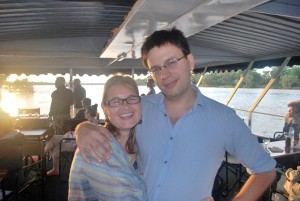 Curiously my eyes glanced over the water, where was this big mammal hiding? There.. See that ripple? Yes, I recognized two little ears and then slowly its eyes came above water.. I started shooting pictures like crazy.
Curiously my eyes glanced over the water, where was this big mammal hiding? There.. See that ripple? Yes, I recognized two little ears and then slowly its eyes came above water.. I started shooting pictures like crazy.
Lazily the animals stayed in the cool Zambezi River while we lingered and lingered around, hoping to see more and more. But no, they kept to themselves, protecting their babies. As the boat cruised further we enjoyed bird watching, seeing the steam of the falls rising high into the air and chatting away in the fading sunlight.
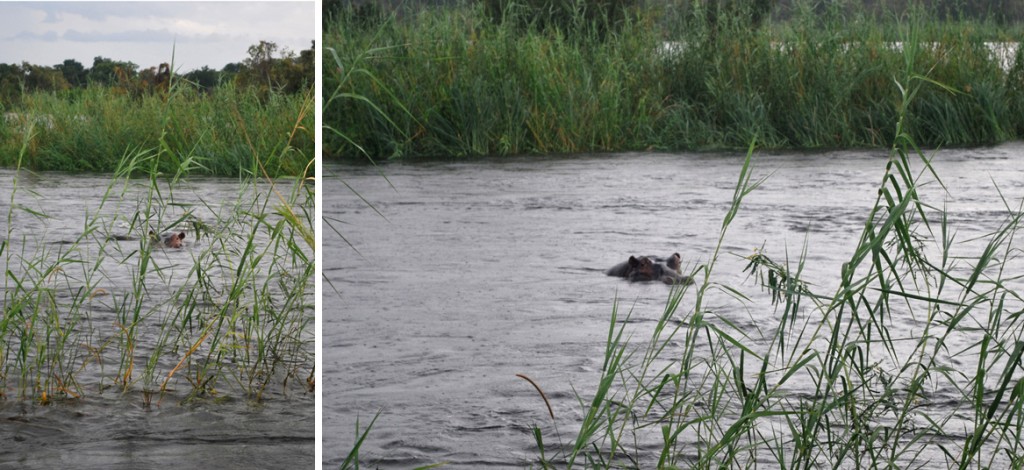
Suddenly, the guides started ushering us animatedly to the other side of the boat, this time we were closer to a group of hippos! Breathlessly I took more and more pictures. One of the hippos didn’t seem to keen on us though.. He revealed himself and started flicking his tail. I was in awe of this large animal that was able to stay so quiet in the water we probably would never have seen it with our inexperienced, square, computer eyes.
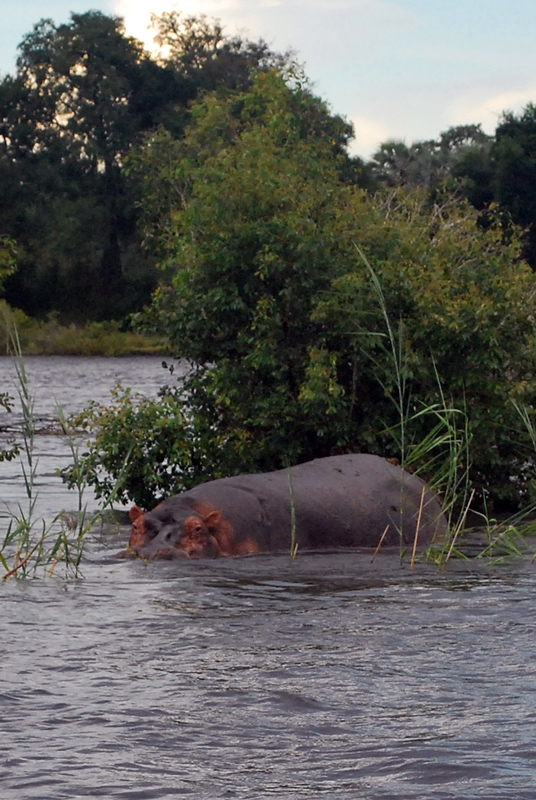
The rest of the evening was great, but that one moment I cherish. Hello Mr. Hippo, nice to meet you. Keep well and hopefully we will meet again!
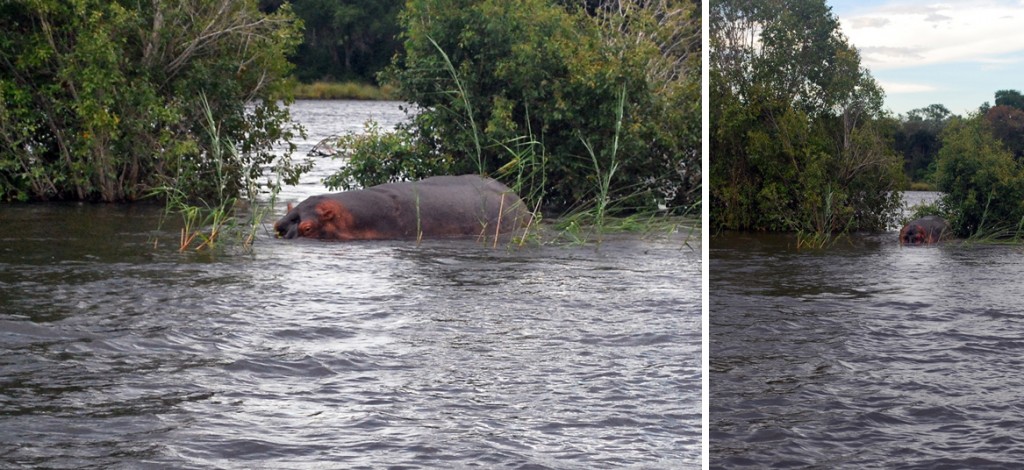
My next blog post about our trip to Victoria Falls will be about the
cultural events
we undertook. Also up and coming is
nature’s beauty
…
18-03-2013
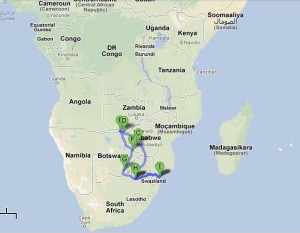 The next blog posts will be related to our recent trip to Victoria Falls in Zimbabwe. The first part of this series is about the first leg of our trip.
The next blog posts will be related to our recent trip to Victoria Falls in Zimbabwe. The first part of this series is about the first leg of our trip.
Going to
Zimbabwe
by bus and train is cheap and very long. We knew this beforehand, but have since learned a few new things. Marlowe, Chris, Tim and I took the Intercape bus from Maputo to Johannesburg in South Africa. Ten hours of trying to fall asleep, reading Game of Thrones, making jokes and stretching the legs eagerly during breaks.
In other words, after the initial feeling of excitement about our trip, we got a little bored.. We arrived an hour late in Jo’burg and had to check in immediately for the next part of the trip: to Bulawayo in Zimbabwe! Quickly we bought some food to tie us over and sat down in the sleeper bus. Via Pretoria we left South Africa and entered Zimbabwe through
Beitbridge
.
Now that’s a story to tell… Alert to all over-land travelers in Africa – do NOT enter Zimbabwe through Beitbridge! Avoid it at all costs, the border crossing is so inefficiently organized that we spent 4 hours waiting to just get in. Yawn, did I mention yet that it was 2am in the morning when we got there?
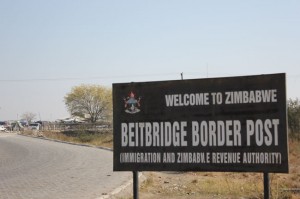 There were a lot of buses, something we had not expected in the middle of the night. And so the line did barely get any shorter during the long hours we had to wait. At times I sat down beside the line and almost fell asleep with the fumes from a bus tickling my nostrils. I didn’t care. I just wanted sleep.
There were a lot of buses, something we had not expected in the middle of the night. And so the line did barely get any shorter during the long hours we had to wait. At times I sat down beside the line and almost fell asleep with the fumes from a bus tickling my nostrils. I didn’t care. I just wanted sleep.
When the line finally started moving round 5am, life seemed doable again. It was so anti-climatic to get a stamp in my passport in an army tent; it took no more than a minute! At least I was awake enough to smile back to the government official.
When we found the bus again, we quietly entered Zimbabwe. I felt like cheering! Only then did I remember we were still not going to get any sleep as we now had to go to the Zimbabwean government official to get yet another stamp in our passport. (They are fond of stamps in Southern Africa; you get one when you leave the country and one when you enter the neighbouring country.)
We applied and received our
visas
relatively fast; it took 2 hours in total. Once the government official found the accountant, our precious dollars were accepted. Meticulously our personal details were written on our self-adhesive visas and placed in our passports. Woohoo, Victoria Falls here we come!
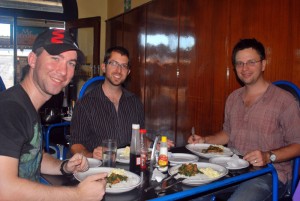 Without much effort we slept most of the way to central Bulawayo, which felt like a small industrial town yet turned out to be the second largest city in Zimbabwe after the capital Harare. Quickly we cabbed our way to the train station to get some food and tickets for the next leg of our trip.
Without much effort we slept most of the way to central Bulawayo, which felt like a small industrial town yet turned out to be the second largest city in Zimbabwe after the capital Harare. Quickly we cabbed our way to the train station to get some food and tickets for the next leg of our trip.
We spent the couple of hours waiting in and around the train station where Marlowe and I started recollecting fond memories of our train travels in India while grabbing a beer to recover from Beitbridge. Too bad we did not have time to check out any of the museums or walk around the city centre before the sleeper train left at 7pm. Nope, we were stuck in the not-so-great part of town.
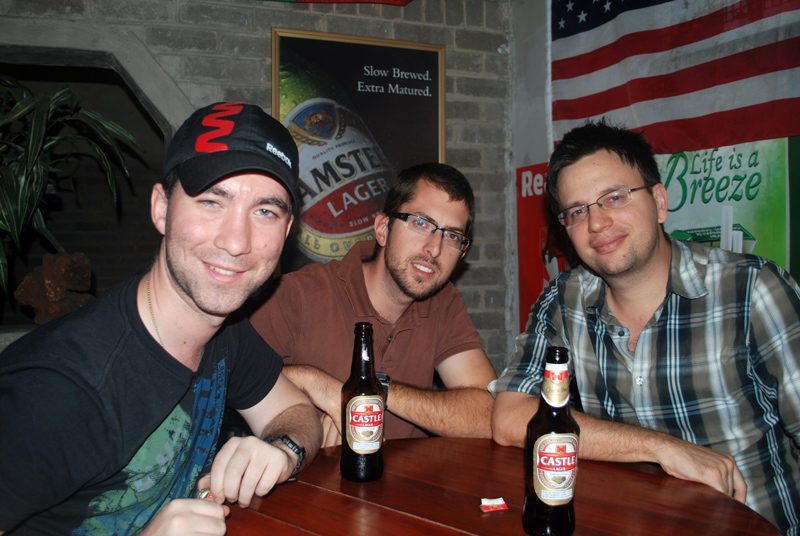
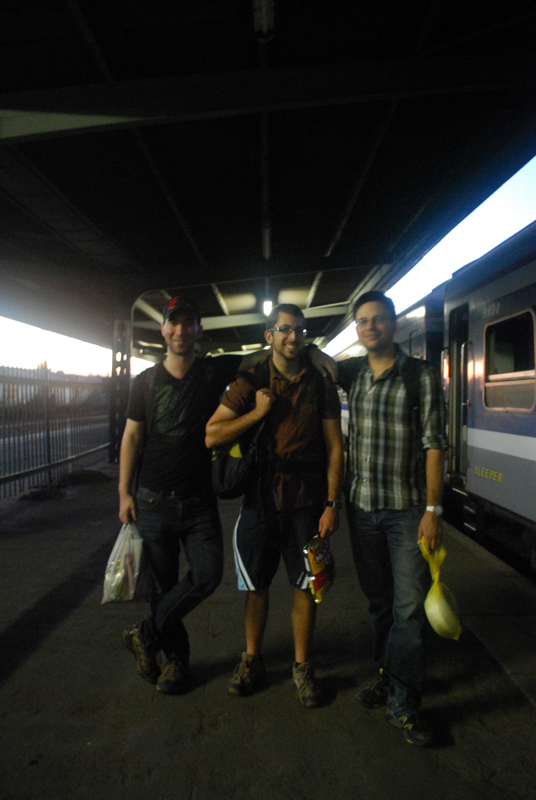
Several card games later we turned in early, impatient to stretch out on our bunk beds. I slept like a baby! This train was also delayed but it gave us opportunity watching baboons play and discovering small villages with traditional roundavels (round thatched mud huts).
Just before noon we finally arrived at our destination:
Victoria Falls
! After 30 hours of travel, we couldn’t wait to have a proper meal, a shower, and just being in one place for at least 54 hours. My next blog post will be about
the Zambezi River and its hippos
.
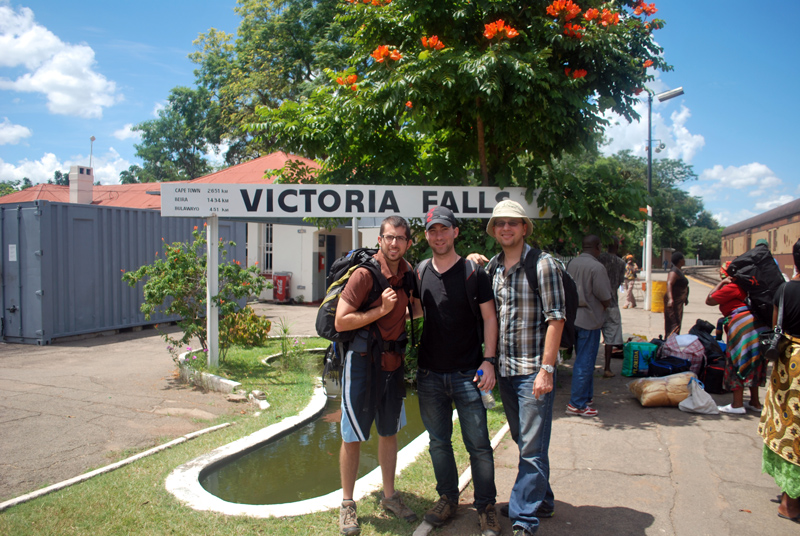
04-03-2013
 In the past two weeks a few things have changed dramatically in our lives here in Maputo.This blog is a mixture of sharing what’s up and how I feel.
In the past two weeks a few things have changed dramatically in our lives here in Maputo.This blog is a mixture of sharing what’s up and how I feel.
What changed is that I feel more alarmed about the security of foreigners living in Maputo. This feeling will change in time to the normal ‘you’ll be fine’ attitude. Of course, common sense is always important. We know what places to avoid and that nighttime is more dangerous (ladies, put your valuables in your bra). Taking public transport is fine and certainly recommended if you want to know ‘the real deal’.
The recent burglaries, (armed) robberies and muggings in the past three months or so are making me exceedingly uncomfortable. Perhaps I am too used to feeling safe at night. But when is it “too much” to wanting to feel safe?
When I walk around, even during day, I find myself glancing around to check out whose coming up closer to me on the pavement. My shoulder bag is usually not just hanging loosely, no I’m firmly holding on to it. I tend to stay clear from people, not always easy when you’re trying not to trip over the sidewalk that is broken in many bits and pieces.
Sure, this feeling of insecurity will pass. In fact, I can’t wait for it to happen! For now, I’m trying to interact with guards, hoping they will remember me and feel they should help in case it would be needed. Naturally, some are fast asleep on their three-legged-broken-plastic-chair-that’s-only-good-for-the-dumpster.
 The second big thing is that my work with ARISO will be ending soon. I have been able to contribute much in the past few months to enhance my colleagues’ ability to write proposals. I also facilitated a workshop evaluating the organization’s strategic plan to revise and renew their focus for the next two years.
The second big thing is that my work with ARISO will be ending soon. I have been able to contribute much in the past few months to enhance my colleagues’ ability to write proposals. I also facilitated a workshop evaluating the organization’s strategic plan to revise and renew their focus for the next two years.
It wasn’t easy. A lot of capacity building went into working towards quality proposals. We discussed the need for developing a program before writing a proposal as financially constrained organizations find themselves creating programs depending on the potential donors’ guidelines and priorities.
More importantly, a program needs to be designed per the needs of the clientele and with the expertise of the organization. Once this program is in place, map potential donors, think hard how you want to approach them (get to know them!), and then write proposals. I am proud to say we have developed an innovative program. Since we are contacting prospective funders, I cannot elaborate yet about the program.
With lack of time and pressure to find sustainable funding, I felt like I had to race against the clock. Last week we had a meeting with several district wardens about the conditions of prisoners. We couldn’t afford a translator else I would have been facilitating this. The outcome of this meeting was important, and even more so, we were having an actual dialogue. Hopefully, progress will be made in this year now the conversation started.
Many other opportunities to work with my colleagues had to give way to finding strategic focus and constructing an actionable, realistic operational plan. And now, my tenure with ARISO ends three months early. What I will be doing in the next three months, I don’t know yet though some opportunities are found.
 And then there is Victoria Falls in Zimbabwe! The 1,5 kilometer wide Zambezi River plunges into 100 meters of vertical chasm and I get to see this wonder of the world at the end of the week. It takes two days to get there, but I can’t wait to start the journey with Marlowe and two friends. My camera is already packed…
And then there is Victoria Falls in Zimbabwe! The 1,5 kilometer wide Zambezi River plunges into 100 meters of vertical chasm and I get to see this wonder of the world at the end of the week. It takes two days to get there, but I can’t wait to start the journey with Marlowe and two friends. My camera is already packed…
Living and working abroad, it’s an emotional roller coaster!
Baking in Maputo
17-02-2013

Apple crumble!
I am so fond of cooking and eating home-cooked food that I wonder at times if I should not start a food-blog. Especially now I am advised to eat
gluten-free
. With more time on my hands than I had in Toronto, it makes sense to spend more time in the kitchen.
Regularly I find myself in more than one supermarket or vegetable markets to find that particular ingredient that is needed for tonight’s dinner.
Luckily we live in a neighbourhood where it’s not hard to find Indian and Middle Eastern spices. But to find Mexican salsa or cauliflower, I have to go out of my way. Even more so when it comes to gluten-free food products.
As those following me on
Facebook
know, we got a new oven in January and within days I started grilling chicken and baking nachos and spring rolls. (Yes, spring rolls do not need to be deep-fried!) Last week I baked an apple crumble with sweet apples bought in
Swaziland
.
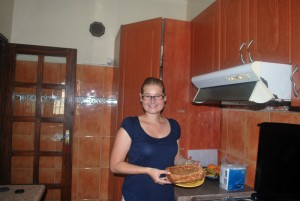
Gluten-free bread.
And more importantly, I got all the ingredients and made my very first gluten-free bread! Ok, I’ll be honest most of the ingredients were pre-mixed and there was no kneading involved. Which made me happy for a first try and knowing I’m not such a fan of kneading and getting dough under your nails. Making
cornbread with broccoli and cheese
is more my style!
Now, the stakes are higher. I promised Marlow to make him a
rye bread
. There’s only one store that I know where you can get proper bread and the price is ridiculous high. Out of principle, we never bought the bread.
Looking at the list of ingredients, it doesn’t seem to be too difficult to buy it all. Yeast, molasses, bread and rye flour, cocoa powder.. am sure it’s all easy to find. And so it was, except molasses that Marlowe tried to find everywhere. We decided to substitute it with brown sugar.
Everyone warns me the consistency of the dough will be different. Hmm, having never baked bread before that does not mean anything to me. Marlowe is thankfully helping me, as he’s the wizard when it comes to making dough. I have just never enjoyed getting sticky stuff on my hands and under my nails!

Turns out our rye flour has good quality, but our regular flour is awful. We added extra flour and Marlowe started kneading. Then I understood the comment about the consistency, gluten-free bread is much wetter.
Looking good… First rise worked, second rise worked.. In the oven it went! Apprehensively, we kept checking up on the bread. It sounded hollow when tapped as directed by the recipe, just looked darker and smaller.
The taste is surprisingly scrumptious for the first try! We vow that our next try will be with good quality flour, and perhaps extra yeast if we need to add more flour to get the right consistency. Looking forward to our next baking adventure. What will it be?

15-02-2013
So what do you do when an important document was due to be sent and hour ago, your laptop won’t start due to some unknown error and the office you’re using suddenly loses power? There’s a UPS (backup battery) but it hasn’t worked in a while. You’re staring at a dead screen in a dark office.
Well, you disconnect the tower and bring it, via chapela (auto-rickshaw), to the place you were going to send it. That’s what me and my boss did yesterday when the rolling blackouts of Maputo hit after a two-day respite. Carrying the tower in our hands, we walked to the nearest chapela stand and rode over to the office. There, we scrambled under tables for the right cords and got to work. About an hour later, we had the job done and were on our way back to the (still powerless) office.
That’s right folks, that’s how you get it done in developing countries.
11-02-2013
Ever since my visit to the Cadeia Central de Maputo (prison), I am anxious to write a blog post about a dance I saw performed by prisoners. Some say this particular dance, called Mapiko Dance, is traditional, others say it is a ritual dance. The origins are not clear even though I’ve been searching online for a little while and asked some people about it.
What is a constant in the explanation is that the dance is always carried out by a man and is about men dominating women. A friendlier version is that the men are protectors of the women. Either way, to me it is a classic example of a culture in which men control the women. As much as I love traditional dances, these kinds of meanings also ensure that old beliefs keep entrenched in modern day life.

Here’s the interesting part of the traditional dance: it originates in the matri-lineal Makonde society. Oh? That’s confusing then, yeah? Turns out (according to some sources) that this dance has grown out of attempts to challenge the power of women. Hmm, is that so wrong? I don’t know because I have no understanding of the Makonde society. What I do know is that women search for ways to find and gain power in patri-lineal societies.
So perhaps it is merely an outcome of a power play that takes place in
any
society. A more positive take is that it shows people live together and are dependent on one another. No matter who they are, where they live, and what they do for a living. We live in groups and are social ‘animals’. Within these social structures it is important to find ways to co-exist pleasantly. One way is to acknowledge that you’re good in one thing and your partner, family member or friend in something else. This dance’s purpose is to show the women that the men are their protectors.
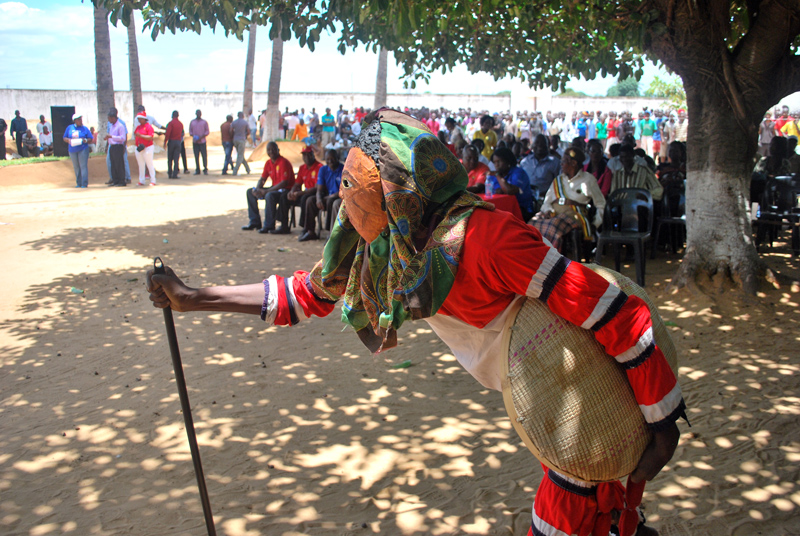
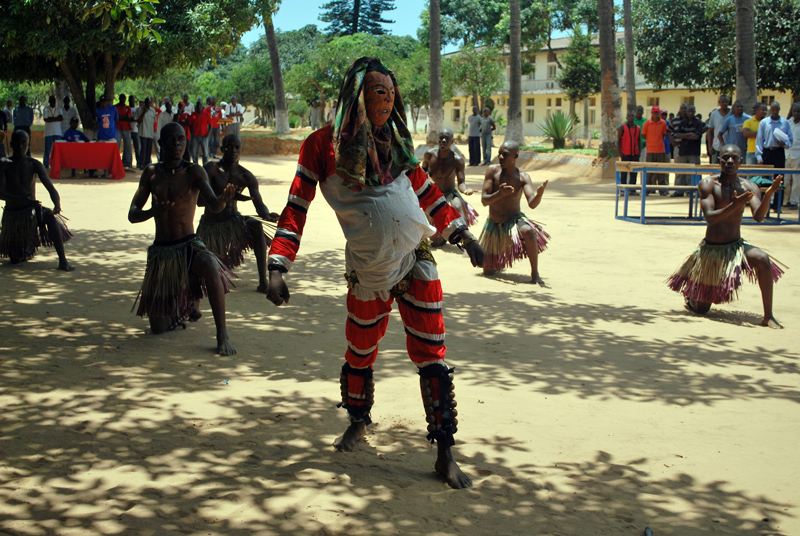
But let me describe the dance for you. After all, I bet you didn’t expect my musings about society and power relations! The dance starts with the women forming a line on either side, while the mapiko is in the centre. The mapiko dancer wears a mask that is decorated with hair, drawings and dyes and wears clothing made from five pieces of cloth to signify he represents a mythical figure of fear that frightens the women and children in the village.
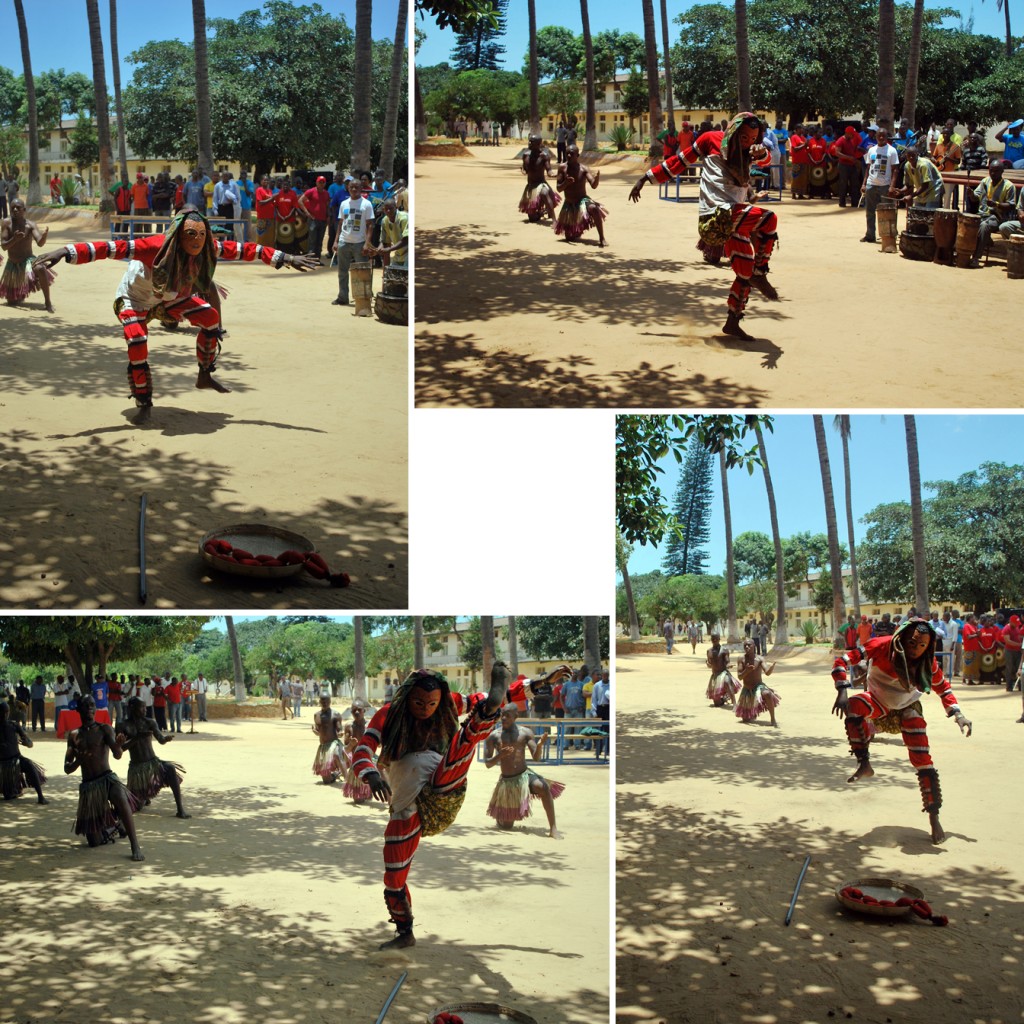
Other male dancers make threatening gestures and shout words toward the mapiko dancer. As they slowly get closer they suddenly show fear and run away with the mapiko on their heals. As he gets close he turns around and starts to dance frantically. His whole body is shaking.

The dance in prison was slightly different from this account. For starters, there are no women in this male facility, so we only had men dancing in a circle. The mapiko dancer appeared quite sudden and it seemed to me the men were pleading with the dancer. As I don’t speak any of the local language and the people around me were unable to explain the dance, I am certain the meaning could be entirely different from my interpretation of their body moves.
The mapiko then danced alone for a little while. Hereafter he went to the group and the men circled around him. He eventually “broke free” and danced some more before leaving the stage. It was absolutely amazing to see this dancer move! I have never seen anyone dance like this and be gracious at the same time.
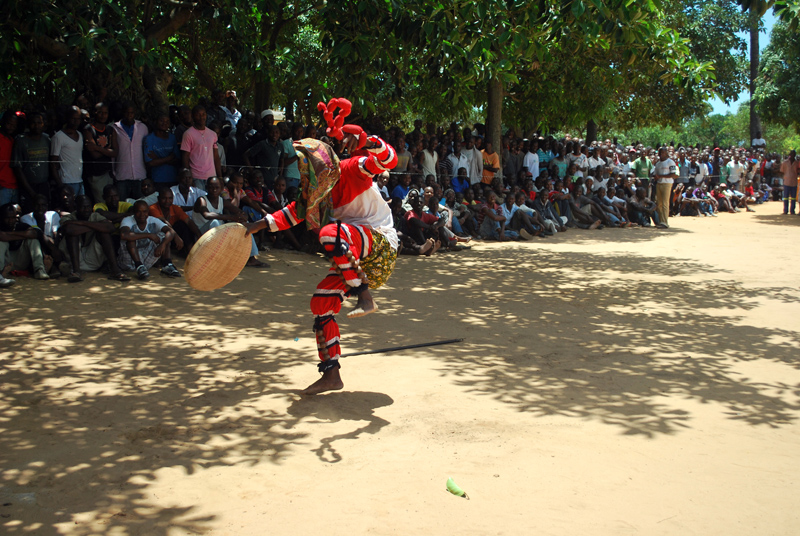
All in all, it was a stunning experience, watching the traditional dance in this peculiar setting.
04-02-2013
So Lisette and I have left Sondzela backpackers and are on our way to start our Sunset Drive tour at a nearby encampment. The map here demonstrates the path taken to the new reserve, which we did at around 3pm to start the tour at 430.
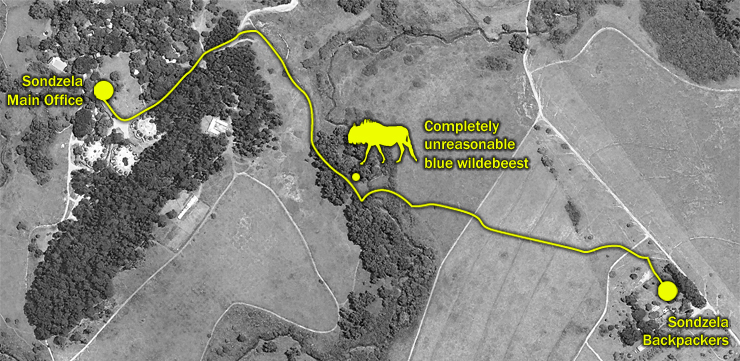
Our path from Sondzela Backpackers to the main camp.
Descending the hill, we saw a bunch of zebras and waterbucks give us wary looks across the grassland. The grassland descended down towards the small river and we breathed easy as the temperature dropped. Crossing the bridge we saw a small group of zebra grazing warily over a tall but thin forest canopy. It turned sharp right and into a glade some 100 meters ahead. However, on that path stood a dark shape that wasn’t so happy we were there.
The dark shape turned out to be a blue wildebeest, a creature weighing some 250kgs and rather territorial. Since most of the animals had kept a wide berth, we carried on up the trail. The wildebeest stood his ground and faced us.
PERHAPS HE NEEDED SOME CONVINCING
I decided that picking up a large branch might remind the wildebeest of a gun and scare him off. This had the opposite effect: he left the trail and mounted a nearby hill, snorting. When he started advancing towards us by coming down the hill, we decided that intimidation wasn’t going to work. Dropping my branch, we moved quickly to the apparent safety of the bridge. With the wildebeest drawing closer (and by closer, I mean about 10 meters away) and plenty of trees, I started assessing how good a climber it might be. Although Lis agreed that we could probably out-climb the ungulate, she wasn’t so keen on finding out.
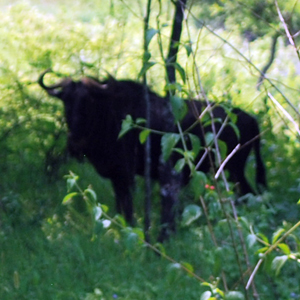
Mr. Unreasonable
Having put some distance between us, the wildebeest relaxed and went back to what he was doing on the trail.
There was no outrunning this thing and intimidation hadn’t worked, so we gave him a very wide berth of about 100 meters and walked around him in a circle. We got to the camp on time and greatly enjoyed our sunset drive with a couple of college students who had just arrived from Canada the day before to begin working in Mbabane. We would run into Mr. Wildebeest a couple more times during our stay at Sondzela and probably blazed a nice circular trail in the process.
Don’t get me wrong, we both
loved
Swaziland, but if you’re in the country and see this guy, I’d stay away.
Devastating flooding in Mozambique
27-01-2013
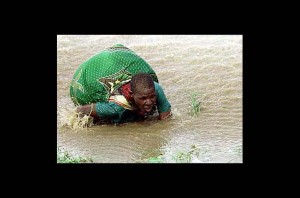
Photo by TIME.com
The inner city of Maputo is extremely lucky, it seems nothing happened here except for a few heavy rainfalls. It’s different in others parts of the city and worse outside Maputo Province (located in the Southern region of Mozambique). A couple of days ago, the Disaster Management Coordination Council (CCGC) declared a red alert. The same day, flooding in Gaza Province left 5 people dead and an estimated 30,000 people in need of evacuation.
About ⅓ of them have been moved to temporary shelters higher parts of the country. Others are stranded on rooftops and waiting for evacuation boats. Every year, high water outflow from South Africa reaches the Limpopo and Incomati rivers leading to extreme high water levels. This year, the dyke in Chokwe was already damaged by heavy rains in 2012 and not fully restored, causing 30,000 people to be moved.
In Costa do Sol, where I work, people tried to limit the damage by filling empty cement bags with sand and place them in front of their streets or houses. Most of the area consists of dirt roads (sand), simple brick houses (few meters wide and long) and even more so mud huts and huts made from grass. The sand filled bags were not much protection and quite a few houses are washed away.
One of my colleagues lost his house. “The sewage system just exploded,” he told me last week. With days of heavy rainfall, the fairly basic plumbing in the area could not handle the large amount of water. His brick house just vanished, along with three others. He had just moved his family to another place and is considered lucky because that means he still has a roof over his head. His former neighbours are not so lucky; they lost almost everything they owned.
A school nearby offered them a classroom so they had a place to sleep and government officials are able to find them. People donated some clothes and food. But how long can they support them? A small committee has been set up to support them and help them advocate their cause. It may take 6 months or longer before affected families will receive government support to rebuild their lives. That is a long time if you have no resources to fall back on!
Yesterday, the flood reached coastal town Xai-Xai, forcing the closure of a major north-south road. Damaged or lost housing leads to immediate tragedy for Mozambicans while the road closure leads to economical tragedy. Add to that damaged bridges, closure of basic services such as banks, shops and hospitals and the socio-economic consequences could be huge.
It hasn’t been raining for days in Maputo, and life seems to return to normal. Yet, if we open our eyes we see slums that have been greatly affected, churches that are completely flooded and some people lost their business. One of VSO Mozambique’s partner organizations, AGRODEC, lost their administrative building and demonstration center. Meanwhile, intense rains are expected in the central and northern regions.
Already, about 70,000 people have been displaced across the country according to the UN who urges donors to make funds available “to help deal with this emergency in the impoverished nation”.
25-01-2013
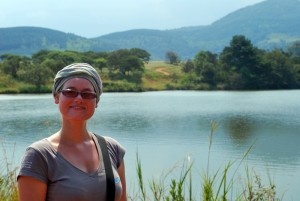 Two weeks ago we left for a short trip to
Swaziland
due to visa legislative rules. We chose the Kingdom of Swaziland because we had already seen Nelspruit (well, a little of it) in South Africa and wanted to maximize our opportunities of seeing different parts of Africa.
Two weeks ago we left for a short trip to
Swaziland
due to visa legislative rules. We chose the Kingdom of Swaziland because we had already seen Nelspruit (well, a little of it) in South Africa and wanted to maximize our opportunities of seeing different parts of Africa.
And we’re so very happy we did! The trip is easy, we left early morning yawning in the back of a chapa.
The wait at the border was the only hick-up as some hard-working Mozambican ladies wanted to export some goods for sale. Every item had to be accounted for. And make no mistake; this had to be done single-handed, one-by-one!
When we finally arrived in Mbabane, Swaziland’s capital, we were pleasantly surprised. It’s a cute little town with a seemingly amiable lifestyle. Our trip to the High Commission was fairly easy and we set out to find Mlilwane Wildlife Sanctuary.
While we were going from one place to the other (change bus, pay at the bank for the visa, return to the High Commission, go to the park, wait for transportation) I kept glancing happily around me. The roads are in amazing shape compared to Maputo. The cars are in fantastic shape when comparing them to my daily chapa (mini-bus) that is so rusty I am regularly staring at the road between my feet. The people look happy, content and friendly.
And there are mountains! Everywhere I looked I saw another hill. Maputo, my normal base of operation, is situated at the waterfront. I have always like being close to water but as it is dangerous here at some parts, I don’t get to enjoy it regularly. Swaziland on the other hand is landlocked and surrounded by lush, green hills.
Despite my vertigo
, hills and mountains always intrigue me. They look so inviting. Marlowe sure thought so as he kept telling me “Don’t you just want to climb that hill?” while he pointed at a very steep hilltop. Mwah… “Not that one!” I say each time. Must have given off some serious confusing vibes!
Despite or in spite knowing that Swaziland is experiencing some of the same major issues (e.g. isolated communities, HIV/AIDS) as Mozambique, we felt very different. For me, it was also very nice to be able to speak English to everyone, as most people spoke it quite well.
It was great to see warriors in the streets with their traditional attires. Swati are proud people and it was a joy to see them celebrate their history and tradition in everyday life. It is one of the many things I loved about
being in India
and that I miss in Mozambique. Perhaps it is because we live in the capital that is very westernized.
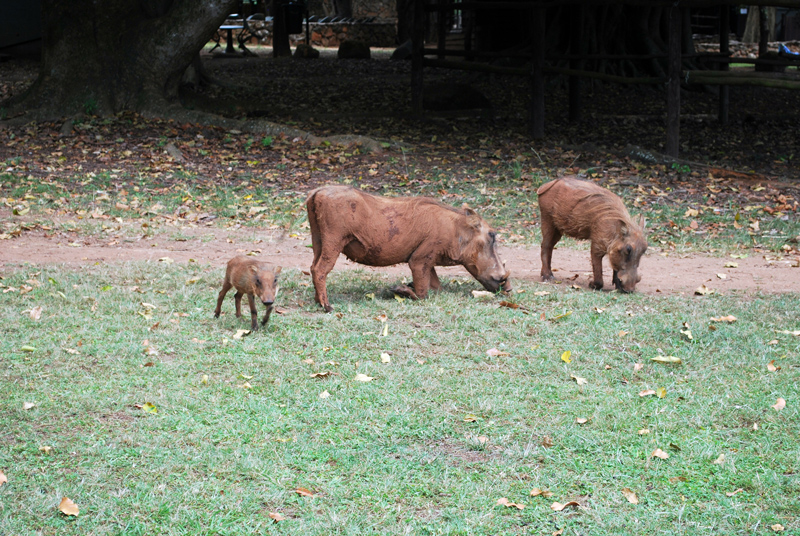
Warthogs
The sad part is knowing that the existence of the country is seriously threatened by the HIV/AIDS endemic. According to the UNDP, the “longer term existence of Swaziland as a country will be seriously threatened” as the infection rate is extremely high. Over 50% of adults in their twenties are HIV positive and Swaziland has the lowest life expectancy in the world with almost 32 years.
When we got to the park, we were ready to enjoy the beauty of the country. It was so hot and sweaty that all we wanted to do was get in the swimming pool and drink a cold beer. Worked like a charm! The next day was divided up in three parts: a) getting our passports back with a brand-new multiple entry visa, b) doing a hike during the hottest part of the day and take the sunset drive tour, and c) chilling out on the deck.
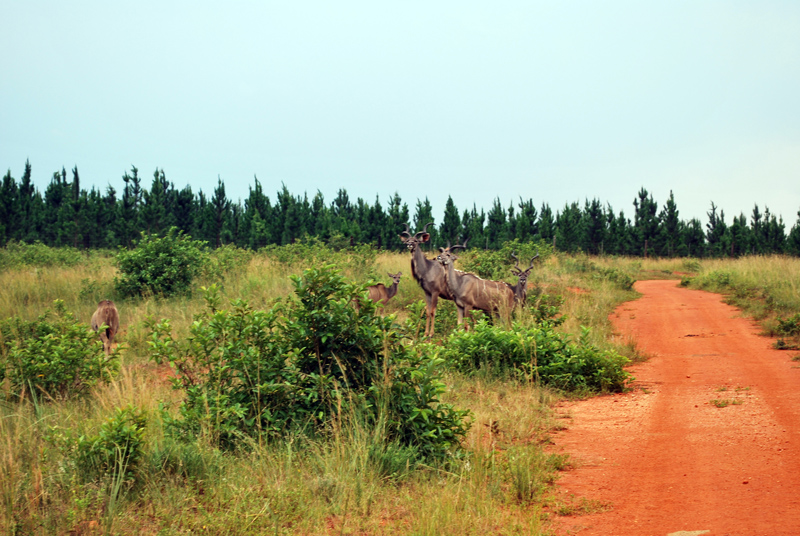
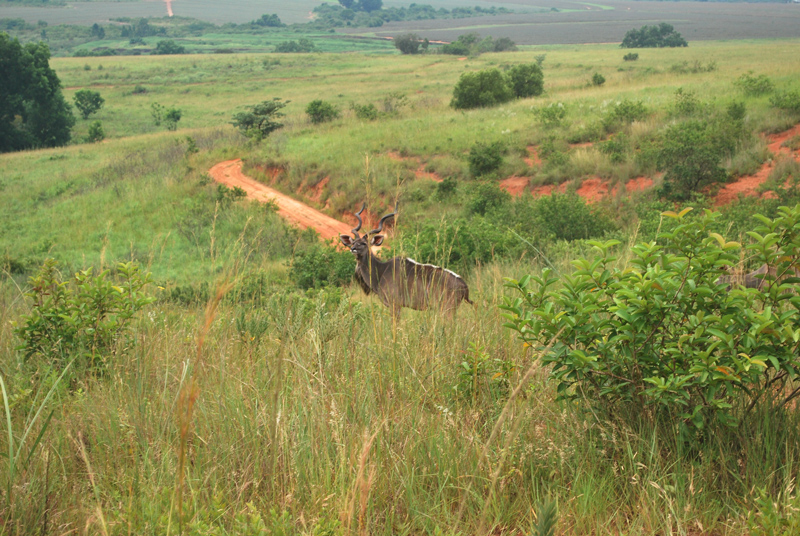
Mlilwane Wildlife Sanctuary
has now joined my “favorite-places-of-the-world” list! The park is small, with grassland plains and striking Nyonyane Mountain (its exposed granite peak is known as “Execution Rock”), well kept and the wildlife abundant. It is not a park that has the Big Five (lion, elephant, buffalo, leopard and rhino), though it mentioned it had a leopard somewhere. However, we were able to walk around freely and be part of nature.

See how the wildebeest moved from its spot and stared us down.
Not far from the hotel we saw zebras looking carefully at us, blesboks looking intently at our goings, and a scary-looking blue wildebeest. Being new to nature walking in Africa, encountering a wildebeest is quite exciting. It was in our path and we, somehow, had to get around it. Marlowe is writing
this blog post
with a detailed description of our anxiety and survival techniques.
We saw several different types of antelopes (steenbok, impala, waterbuck, reedbuck, nyala) and quite a few warthogs (a type of wild pig). The birdlife is stunning here and the sunset drive revealed a sunbathing crocodile for us.
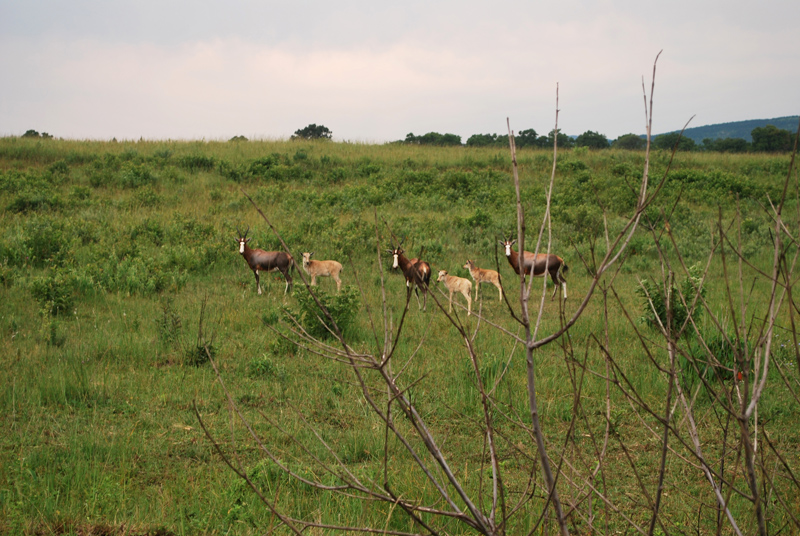
Blesboks.
As we took our time viewing wildlife, our guide had to rush us up to the top for a very nice sunset. While there, the lightning started and we knew there would be some heavy rain later on. We didn’t care too much about it, we were safe and dry inside the hotel and were ready to cool off.
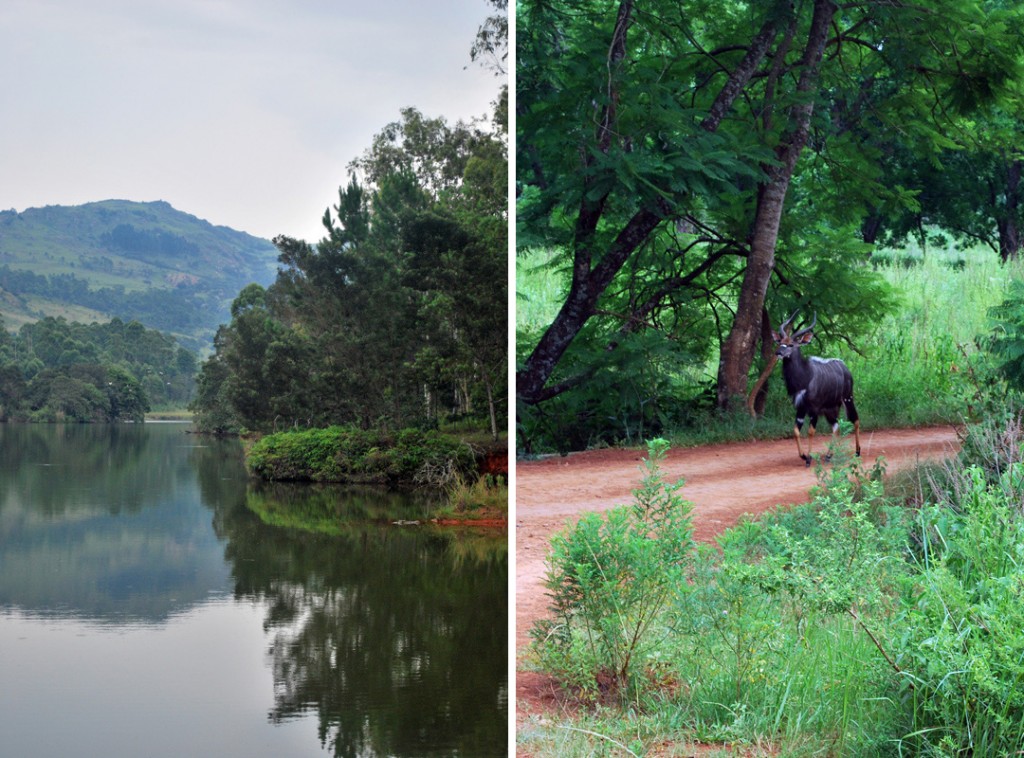
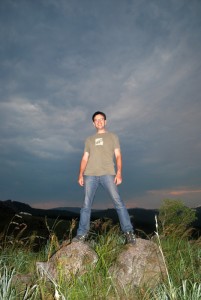 On the last day we hiked as far as possible up on the mountain. It was relatively easy with good trails, but as we got higher the ants seemed to be everywhere and you couldn’t stand still for one minute or they’d run up your legs and bite you. And of course I had to have another bout of fear when the trail was barely identifiable and seriously overgrown with thorny bushes.
On the last day we hiked as far as possible up on the mountain. It was relatively easy with good trails, but as we got higher the ants seemed to be everywhere and you couldn’t stand still for one minute or they’d run up your legs and bite you. And of course I had to have another bout of fear when the trail was barely identifiable and seriously overgrown with thorny bushes.
The way back home was easy. We took a chapa back via Manzini and the drive was a little electrifying. Both Marlowe and I sat on the front seat and saw as the wind and rain chastised the mini-bus. The driver could barely see anything, so he was driving slower than slow. Honestly, he did a great job getting us to the border.
At the border we had to wait again for someone who was importing a lot. Eventually, the chapa driver arranged for us to take another bus that was ready to go. Now that’s customer service for you!
All in all, a trip we’d love to experience more often. Lucky us, our multiple-entry visas mean we have to leave Mozambique every thirty days! We thought we had it sorted out and would be fine from now on, but no… this visa also stipulates we have to leave the country every month. Where shall we go in two weeks from now?
Review for “Herkenning” (“Recognition”)
23-01-2013
Today I wrote a review for Gaby Sadowski’s book “Herkenning” which translates into “Recognition”. As the project is in Dutch, so is my review (see below). Gaby, whom I first met when we were eleven years old, has always been extremely communicative and able to reach out to anyone. Her latest, personal, project is using more than one kind of media to create a storyline.
The virtual world holds no secrets for
Gaby
, she was one of the first to embrace it and use it in all its facets. Recognition is an innovative trans media project that covers a traditional manuscript, Twitter, Facebook and blogs.
So how does this work? Simple, the two main characters of the manuscript are on social media and interacting with anyone who is interested. This gives you the unique chance to influence the storyline as you start a dialogue with one or both main characters.
From the get-go, I loved the story about
Mila’s search
about her role in life. She used to be a successful lawyer with her own practice but within one year she turned into a neglected housewife, moved from the Netherlands to France and is starting an olive orchard.
Getting the orchard off the ground is, literally, hard work and Mila finds it symbolic for her struggle to give meaning to life and making sure she stands up for herself, as she finds no support from her husband.
Mila is lonely and starts reminiscing about the past. She tries to drive the loneliness out by reaching out to people via the Internet and she just started a blog. And now she found Chris.
Chris
, her long lost flame from twenty years ago.
Using social media, Gaby invites the public to help her write the story of Chris and Mila. Befitting a trans media project, you can buy shares in the manuscript through the crowd funding website
tenpages.com
.
Recensie in het Nederlands
:
Het transmediale project van Gaby Sadowski begon met het schrijven van een boek en is al gauw gegroeid tot een innovatief sociaal en communicatief project dat gebruikt maakt van de populairste elementen van de virtuele wereld.
Het boek, de blogs en de twitter-berichten laten je kennis maken met Mila’s zoektocht. In één jaar tijd is de hoofdpersoon, Mila van den Elzen, omgetoverd van succesvolle advocate in een huisvrouw die voor haar gezin moet zorgen en haar zelf wegcijfert. Mila vraagt zich wanhopig af of dit nou haar lot is.
Dit is dan ook de reden waarom ze haar olijfboomgaard niet opgeeft, haar geploeter op het land is hét symbool dat ze voor zichzelf opkomt. In de tussentijd probeert Mila zich minder alleen te voelen door contacten te onderhouden via Internet. En zo vindt zij haar oude vlam Chris.
Dit transmedia project geeft jou de kans om met Mila en Chris mee te zoeken naar hoop voor de toekomst. Gaby moedigt je aan om te communiceren met haar twee hoofdpersonen en zo het verhaal te beïnvloeden. Ik zou zeggen, begin met het kopen van aandelen in haar manuscript om het via ‘
crowdfunding
‘ gepubliceerd te krijgen. Ik deed het net zelf.
 I’ve been
dreaming
for a long time to meet a hippo up close and personal. Marlowe always jokes that I would jump in the water at first sight and try to hug a 7,000-pound animal. When I heard hippos lived close to Victoria Falls, I naturally wanted to start arranging for sights to see and do as soon as possible after arriving at the Falls (in spite of an enormous tiredness that fell over me after
our long journey from Maputo
).
I’ve been
dreaming
for a long time to meet a hippo up close and personal. Marlowe always jokes that I would jump in the water at first sight and try to hug a 7,000-pound animal. When I heard hippos lived close to Victoria Falls, I naturally wanted to start arranging for sights to see and do as soon as possible after arriving at the Falls (in spite of an enormous tiredness that fell over me after
our long journey from Maputo
).
 Curiously my eyes glanced over the water, where was this big mammal hiding? There.. See that ripple? Yes, I recognized two little ears and then slowly its eyes came above water.. I started shooting pictures like crazy.
Curiously my eyes glanced over the water, where was this big mammal hiding? There.. See that ripple? Yes, I recognized two little ears and then slowly its eyes came above water.. I started shooting pictures like crazy.






























 Two weeks ago we left for a short trip to
Swaziland
due to visa legislative rules. We chose the Kingdom of Swaziland because we had already seen Nelspruit (well, a little of it) in South Africa and wanted to maximize our opportunities of seeing different parts of Africa.
Two weeks ago we left for a short trip to
Swaziland
due to visa legislative rules. We chose the Kingdom of Swaziland because we had already seen Nelspruit (well, a little of it) in South Africa and wanted to maximize our opportunities of seeing different parts of Africa.






 On the last day we hiked as far as possible up on the mountain. It was relatively easy with good trails, but as we got higher the ants seemed to be everywhere and you couldn’t stand still for one minute or they’d run up your legs and bite you. And of course I had to have another bout of fear when the trail was barely identifiable and seriously overgrown with thorny bushes.
On the last day we hiked as far as possible up on the mountain. It was relatively easy with good trails, but as we got higher the ants seemed to be everywhere and you couldn’t stand still for one minute or they’d run up your legs and bite you. And of course I had to have another bout of fear when the trail was barely identifiable and seriously overgrown with thorny bushes.